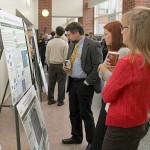Civil Engineering Graduate Seminar
This Thursday, Jan. 24, at 4 p.m. in Dow 642 the weekly civil engineering graduate seminar series will begin. Our first speaker will be Dave Reed, vice president for research. Reed will address various topics associated with his office and the University’s commitment to research. He will also answer questions from the audience. All members of the Michigan Tech community are invited to attend.
 The fall 2012 senior design team presentations of the Civil and Environmental Engineering Department were presented to the University community Tuesday, December 11 and Thursday, December 13 . This semester students in five sections have undertaken a wide range of interesting projects to fulfill the Department’s design project requirement.
The fall 2012 senior design team presentations of the Civil and Environmental Engineering Department were presented to the University community Tuesday, December 11 and Thursday, December 13 . This semester students in five sections have undertaken a wide range of interesting projects to fulfill the Department’s design project requirement.
Presenter: Renee Oats, PhD Candidate, Civil and Environmental Engineering
November 8, 2012; Dow 641; 4 pm
Title: An Evaluation of Using Digital Image Correlation for Condition Assessment of Bridge Infrastructure
Abstract: Digital Image Correlation (DIC) is an advancing optical technique that is gaining popularity for quantifying bridge response using a series of incremental digital images. DIC refers to a measurement technique that consists of correlating pixels in optical images. This correlation can be used to monitor 2-D and 3-D measurement changes in images. Included in this presentation is an overview of the DIC methodology and its uses in a variety of applications. This presentation also details an investigation of DIC for condition assessment and structural performance of bridge members and materials in the laboratory setting as well as an in-service bridge demonstration. Additionally, the benefits and challenges of the method will be discussed as well as the future research investigations of this method to enable efficient bridge performance measurements for advancing structural health monitoring of civil infrastructures.
Civil Engineering Graduate Seminar: Nov 29: Graduate student Rachael Barlock (CEE) will present “Bubble Plate for Erosion Reduction” at 4 p.m., Nov. 29, in Dow 641.

Alumni Appreciation Night was held in Grand Rapids. The Civil and Environmental Engineering Department hosted the event which included complimentary appetizers, Keweenaw Brewing Company beer, and pickled eggs as Copper Country treats. Great gifts and giveaways including a signed Michigan Tech hockey jersey, jackets, hats, and more were there too.
Alumni came out to chat with faculty and students from the Civil and Environmental Engineering Department. Also our national award winning concrete canoe and steel bridge – along with senior design projects and more were displayed.
 The sixth annual conference sponsored by Michigan Tech’s international D80 Center was held on Saturday, Nov. 3, at the Great Lakes Research Center. The D80 conferences highlight service and research work done by students and faculty from Tech and elsewhere. They are open to anybody interested in design and development of projects to serve the poorest 80 percent of humanity.
The sixth annual conference sponsored by Michigan Tech’s international D80 Center was held on Saturday, Nov. 3, at the Great Lakes Research Center. The D80 conferences highlight service and research work done by students and faculty from Tech and elsewhere. They are open to anybody interested in design and development of projects to serve the poorest 80 percent of humanity.
Civil Engineering Graduate Seminar October 25: James A. Morrison, PE, Engineering Services Group Manager of Kiewit Engineering Company, will be presenting “The Engineer as Manager and Leader,” at 4:05 p.m., Thursday, Oct. 25, in Dow 641.
Fall enrollment figures show that the number of women undergraduates in the College of Engineering and the total number of graduate students on campus have increased.
Civil Engineering Graduate Seminar Series: Thursday, October 18, 4:05 PM, Dow 641
Analysis of an Electric Vehicle Subscription Service Business Model that Includes Battery Swapping
By Jeff Lidicker, PhD, Assistant Professor of Civil and Environmental Engineering
Abstract
One proposed strategy for facilitating the introduction of electric-drive vehicles is for vehicle purchasers to own the vehicle but to lease the battery from a third party, in order to help reduce the “first cost” hurdle to consumers. A further extension of this concept for all-battery electric vehicles (EVs) would include the ability for consumers to exchange their discharged batteries for charged ones, using “battery swap stations.” These would allow for extended driving range for EV service subscribers, but with increased costs to build and operate the stations. Our analysis centers around a “base case” scenario from 2012–2027 that includes a set of assumptions about subscriber membership levels, gasoline and electricity prices, corporate level expenditures, and the capital costs of batteries, charging stations, and battery swap stations. Our analysis suggests that the economics of this business model are challenging with current gasoline prices and the “base case” scenario assumptions, but that the economics can be favorable under certain circumstances.
 Michigan Tech Research Institute (Ann Arbor) researchers shared their posters and time to talk about their work during a day-long poster presentation session in the Atrium of the Dow Environmental Sciences and Engineering Building. Numerous faculty and students had the chance to study the posters and meet with the researchers for potential internships, collaboration and inspiration.
Michigan Tech Research Institute (Ann Arbor) researchers shared their posters and time to talk about their work during a day-long poster presentation session in the Atrium of the Dow Environmental Sciences and Engineering Building. Numerous faculty and students had the chance to study the posters and meet with the researchers for potential internships, collaboration and inspiration.
View pictures and video clips and links to research project posters and more information